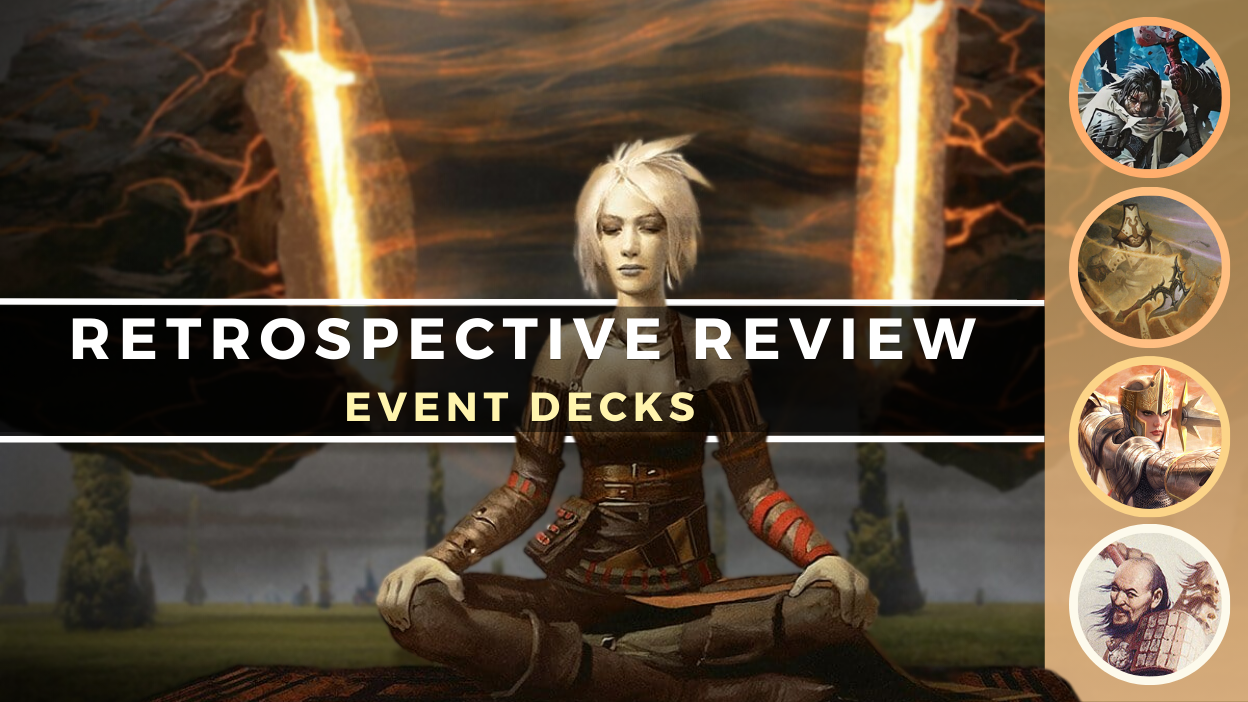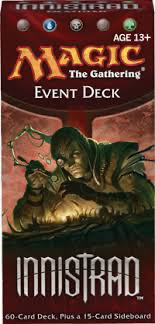Retrospective Reviews: Event Decks

What an Event... Or Were They?
There's no time like the present to dig up the past! It's time for another Retrospective Review! Once upon a time, there was this format called Standard (or Type 2, for those of you with back pain), and it rotated every year. I'm led to believe that this rotation was not a process of spinning the cards in a circle, but in which a year's worth of cards were banned all at once in a strange ceremony. Players were supposed to build a deck from 5-8 sets worth of cards.
Fascinating stuff.
Anyways, trying to get into this format is a bit like jumping on a train that's still moving. Trying to scrounge up all the pieces feels bad when they'll be obsoleted in a few months' time. An immediate purchase helped alleviate that, which Wizards of the Coast provided... in Event Decks!
Let's find out what they were and why they dissolved!
What Were Event Decks?
Event decks were preconstructed deck products intended for competitive play. The product included not just a 60-card deck but also a 15-card sideboard and even a strategy guide to help players understand what the deck's goal and means were. Event decks also included a poster and spindown life counter. In total, they ran for $20 MSRP.
Starting in 2011, Wizards of the Coast released two Event Decks per year before switching to one per set in 2013. They then created a separate but related product, Clash Pack, which would take the slot in every other set in the final year of the product (2014-2015 technically).
In my previous article about Intro Decks and Premium Deck Series, I talk about their deck construction and namely the incredibly high number of 1-ofs in the decks. When crafting for consistency-driven competitive formats, 1-ofs are the enemy, the mind killer. These decks didn't pack themselves full of rares, however, and so 1-ofs still persisted even here.
A Brief History of Event Decks

Let's take a look at summarized look at the decks!
2011 Event Decks
Mirrodin Besieged: Infect & Defile
A Dimir mid-range deck based around infect. Wanted to focus on killing your opponent's creatures before swinging in. Criticized for not focusing on blue's unblockable spells.
Mirrodin Besieged: Into the Breach
A mono-red aggro deck which leaned into the battle cry mechanic.
New Phyrexia: Rot from Within
A mono-green aggro deck focusing on infect. The previous Dimir iteration wanted to control the board in order to get in, while this deck relied on speed and pump spells to make it happen.
New Phyrexia: War of Attrition.
A mono-white aggro deck that used Equipment and the living weapon mechanic to be able to last into the mid-game and later. This one was funky in that it included a card that Wizards of the Coast would ban, Stoneforge Mystic
Magic 2012: Vampire Onslaught
A mono-black deck focusing on Vampires, preparing players for the upcoming fun to be had when Innistrad would debut. Unique for including Verdant Catacombs
Magic 2012: Illusionary Might
A mono-blue deck based around Illusions! Watered down with other stuff, unfortunately, but Illusions just didn't have the card quantity at the time to commit.
Innistrad: Deathfed
The first tri-color event deck, a Sultai deck focused on the graveyard. Fill it up for flashback spells or other shenanigans.
Innistrad: Hold the Line
A mono-white deck that technically focused on Humans but was mostly your typical white weenie deck. How Human-themed can it be with only three Human kindred cards (not playsets... cards)?
2012 Event Decks
Dark Ascension: Spiralling Doom
A Golgari Birthing Pod
Dark Ascension: Gleeful Flames
A mono-red burn deck with plenty of aggro creatures that were perfectly acceptable to sacrifice to hefty but efficient burn spells, like Goblin Grenade
Avacyn Restored: Death's Encroach
A mono-black aggro deck with a strong Zombie throughline. Aggro decks proved to be lower financial value but much better play value out of the box.
Avacyn Restored: Humanity's Vengeance
An Azorius mid-range deck using some flickers and decent creatures, relying on the soulbond mechanic to... muted effect.
Magic 2013: Repeat Performance
A Selesnya deck based around blinking Thragtusk
Magic 2013: Sweet Revenge
A Grixis deck hearkening back to all the flashback spells from the year to make a Burning Vengeance
Return to Ravnica: Wrack and Rage
A Rakdos aggro deck with some burn spells to close things out.
Return to Ravnica: Creep & Conquer
A Golgari midrange deck that wanted to utilize scavenge to positive effect, but, well. It was scavenge.
2013 Event Decks
Gatecrash: Thrive and Thrash
A Jund deck that used mana Elves and Farseek
Gatecrash: Rally and Rout
A Boros deck that wanted to be able to trigger battallion on turn three. Curve out and crash in!
Dragon's Maze: Strength of Selesnya
Flavor fail! This "Selesyna" deck is Abzan! And all for the flashback cost on Lingering Souls
Magic 2014: Rush of the Wild
A Gruul deck that made good use of the bloodrush mechanic, especially Ghor-Clan Rampager
Theros: Inspiring Heroics
An Azorius mid-range deck that leaned on the heroic mechanic. Included a Hallowed Fountain
2014 Event Decks
Born of the Gods: Underworld Herald
A mono-black control deck without a single copy of Gray Merchant of Asphodel
Journey into Nyx: Wrath of the Mortals
An Izzet burn deck with spellslinger synergies.
Khans of Tarkir: Conquering Hordes
An Orzhov deck based around Warriors as the theme. This one might have been a real winner if it hadn't been printed during Siege Rhino
2015 Event Decks
Dragons of Tarkir: Landslide Charge
Temur cements itself as the most-used tri-color in Event Decks with this aggressive midrange deck that ramped out big creatures.
Battle for Zendikar: Ultimate Sacrifice
The final release in the line was the first to include mythics, but this sacrifice deck languished on the shelves due to a lack of performance, which was unsurprising given that there were shifts in how rotation was going to work amongst other problems.
Event Deck Variants!
Two notable related products came out as a result of this product, which I presume held on as a successful entry in the line-up (seeing as it outlasted Premium Deck Series and Signature Spellbooks...).
First, there was the Modern-targeted version, March of the Multitudes, which came out with a whopping $75.00 MSRP. It had Sword of Feast and Famine
Second, there were... Clash Packs. At $25 MSRP, this product was like if Event Decks and Duel Decks had a kid. You opened up two decks which overlapped in colors. These were intended to be played against each other. Once you felt like it, you could smash the decks together with an intended decklist guide inside to have the equivalent of an Event Deck.
Clash Packs were released in Magic 2015, Fate Reforged, and Magic Origins, before the product was discontinued.
What Happened To Event Decks?
The product as a whole had a markedly... variable value. It was intended as a competitive deck, but it had a fundamental flaw: the decks were intended to be Standard-competitive while dropping alongside their set. This meant that designers were including cards that they expected would be tournament-viable but had no real data to base those expectations on. Obviously, the designers are good at this game and have a sense of things, but they can't predict everything. Focusing their efforts became apparent, as they dropped the decks from 8 per year to 4, before the weird shifts with the Clash Pack product.
Then, of course, there's the inherent issue with releasing a Standard-legal competitive deck with every set: the fourth set of the year only has about 3 months before rotation hits.
Attaching the deck to the set also meant that they wanted to pull on one of the set's themes, but this meant that the theme needed to be fairly pushed to be viable. Even if it was, it also had to be pushed within the total Standard environment. As anyone who played during Theros or Battle for Zendikar Standard might remember, this... doesn't always work out.
Finally, the decks usually had several playsets, but very few of them had more than one copy of a given rare, which meant that they could be swingy.
For WotC to make genuinely competitive decks that could actually last, they would need to change up how they made these decks, and they did! Almost three years later, the much more successful and lauded Challenger Deck program launched in 2018 and continues to this day, albeit at a $30 MSRP. Brief list below of the specific changes made!
- Included higher number of playsets
- Rares and mythics often included in multiples
- Based on tournament results, less anticipation involved
The Clash Packs suffered from all the same problems as regular Event Decks, plus the fact that they asked you to assemble the actual deck yourself. Weird stuff, but I could genuinely see the appeal of a 2-in-1 product!
As for the Modern-legal version, I think the MSRP was incredibly high but still not high enough for WotC to ever justify making even a tier 2 Modern competitive deck. Modern had way too many insanely expensive decks for anything other than a mono-red Burn deck to be viable for $75. Fortunately, Pioneer became a thing and $45 entry points were a viable product.
Ultimately, the original Event Decks didn't have the right timing to formulate proper decklists or the "budget" to be good enough for what it truly wanted to do. In true Wizards fashion, they discontinued the product and released an upgraded version at a higher MSRP. They're aware of what happens when you suddenly increase the price on a product, and so they try to avoid that perception where possible.
So, what do you think? How did Event Decks fit in at FNMs? Are Challenger Decks worth paying an extra 10 bucks for? Did anyone buy a Clash Pack? Let me know in the comments below!